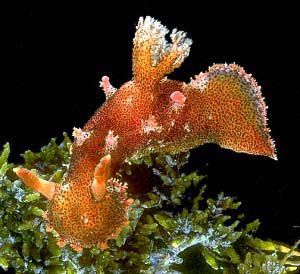
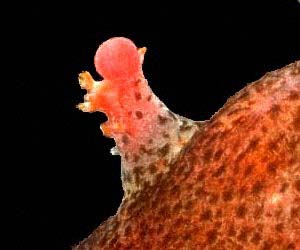
Plocamopherus imperialis
Angas, 1864
Order: NUDIBRANCHIA
Suborder: DORIDINA
Family: Polyceridae
Subfamily: Triophinae
DISTRIBUTION
Known from temperate southeastern Australian waters and northern New Zealand.
PHOTO
Green Pk, Woolgoolga, northern New South Wales, Australia, Nov 1982. Length approx 70mm. Lower photo showing a magnified view of one of the posterior lateral bulbs on the side of the body. PHOTOS: Bill Rudman.
RELATED TOPIC
Species of Plocamopherus have a series of paired papillae down the upper (mantle) edge of the body. Some of these papillae usually have a large bulb at the tip. When disturbed, the bulbs, and other patches on the side of the body, luminesce, producing flashes of light down each side of the body. How they do this and whether light-producing bacteria are involved is unknown.
Species of Plocamopherus also are able to extend the posterior end of their body/foot into a vertical "paddle". When disturbed they can also swim by vigorously flapping their body from side to side like a stranded fish. The paddle-like shape of the posterior end of the body provides necessary propulsion, just like a fish, to propel the slug through the water.
Although it is often found crawling over brown algae, it most probably feeds on arborescent bryozoans, but I know of no direct observations on its feeding habits.
Reference:
• Angas, G.F. (1864). Description d'espèces nouvelles appartenant à plusieurs genres de Mollusques Nudibranches des environs de Port-Jackson (Nouvelles-Galles du Sud), accompagnée de dessins faits d'après nature. Journal de Conchyliologie, 12: 43-70
Rudman, W.B., 1998 (December 21) Plocamopherus imperialis Angas, 1864. [In] Sea Slug Forum. Australian Museum, Sydney. Available from http://www.seaslugforum.net/find/plocimpe
Related messages
Re: Plocamopherus imperialis feeding
March 18, 2009
From: Leanne and David Atkinson


Concerning message #19440:
Dear Bill,
We did a night dive at Fly Point and found this pair of Plocamopherus imperialis mating. Thought it might be of interest to add to your records of its behaviour.
Locality: Fly Point, Port Stephens-Great Lakes Marine Park, Port Stephens , 10 metres, New South Wales, Australia, Pacific Ocean, 07 March 2009, Sandy bottom with scattered sponges, bryozoans, ascidians, soft corals and gorgonians. Length: approximately 70 mm. Photographer: Leanne and David Atkinson.
Regards,
Leanne and David Atkinson
atk@hunterlink.net.au
Atkinson, L. & D., 2009 (Mar 18) Re: Plocamopherus imperialis feeding. [Message in] Sea Slug Forum. Australian Museum, Sydney. Available from http://www.seaslugforum.net/find/22322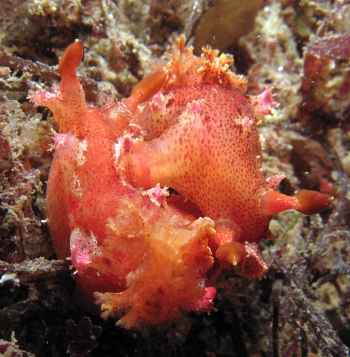
Thanks Leanne and David,
Best wishes,
Bill Rudman
Plocamopherus imperialis feeding
February 27, 2007
From: Leanne & David Atkinson
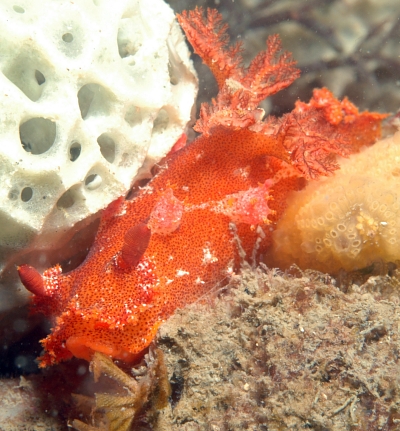
Hi Bill,
We were excited to find this Plocamopherus imperialis feeding. You can actually see a chunk of its prey item in its mouth. Thought this might be of interest to you.
Locality: The Pipeline, Port Stephens, 10 metres, New South Wales, Australia, Pacific, 10 February 2007, Silty, sandy bottom with scattered sponges, ascidians, bryozoans, soft corals and hydroids.. Length: 60 mm. Photographer: Leanne & David Atkinson
Regards,
Leanne & David Atkinson
.
atk@hunterlink.net.au

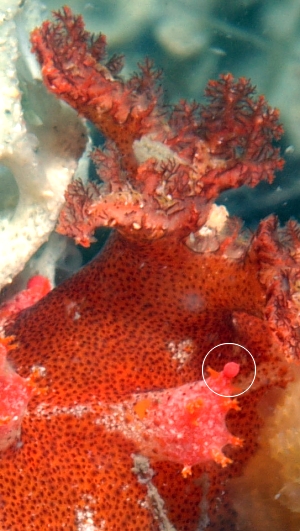
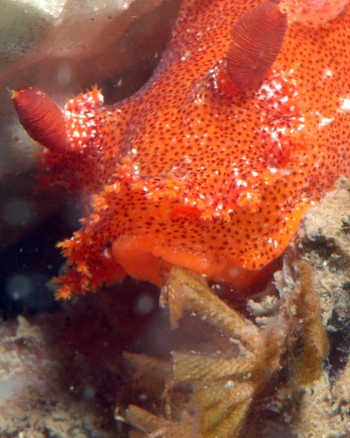
Dear Leanne & David,
Thanks for these nice photos of Plocamopherus feeding on bryozoans. As I say on the Fact Sheet, its relatives feed on bryozoans and it is often found on bryozoans, but until now I knew of no actual observation of it eating them. As they say - seeing is believing. Thanks.
In a message I am posting today on P. ceylonicus [#19542] I discuss the bioluminescent spheres on the lateral papillae in that species and how it seems they can be damaged and regrow. In your middle right photo I have ringed the sphere in this species. if you compare it with the sphere, and its papillae, on the species Fact Sheet it seems that the sphere in your animal is in the process of regrowth. The spheres in P. imperialis differ from those in P. ceylonicus. While in P. ceylonicus they sit at the tip of a relatively narrow papilla (or stalk), In P. imperialis, the papilla is proportionally much larger, being a large swollen base, with the sphere at one corner. Also In P. imperialis the spheres are usually found only on the last papilla on each side, while in P. ceylonicus they can be on any of the four posterior papillae.
Best wishes,
Bill Rudman
Plocamopherus imperialis from Sydney
September 29, 2003
From: Barbara Harvey

Dear Bill,
Here are a couple of photos of a Plocamopherus imperialis I found at Balmoral [Sydney Harbour, New South Wales, Australia] in November 2002
Barbara Harvey
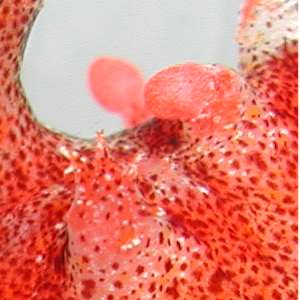


Dear Barbara,
Thanks for the photos. As well as your 'whole animal' photo I have included some enlargements becasue they show the bulbous tip of the lateral papillae behind the gills very well. As I have mentioned elsewhere on this page these bulbous organs emit flashes of light when the animal is maltreated. Flashes of light are also made at other places along the sides of the body, but the is the principal source.
Best wishes
Bill Rudman
Plocamopherus imperialis from New Zealand
April 5, 2001
From: Gareth Jones
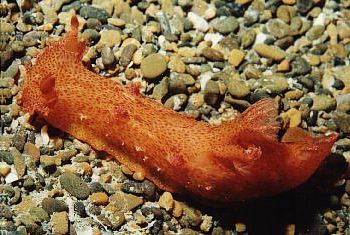
Hi Bill,
I think this is Plocamopherus imperialis. I photographed it recently while diving on the Waikato wreck south of Tutukaka (northeastern New Zealand). 31m deep and water temp 19C.
Cheers.
Gareth Jones
rees@divenz.co.nz
Jones, G., 2001 (Apr 5) Plocamopherus imperialis from New Zealand. [Message in] Sea Slug Forum. Australian Museum, Sydney. Available from http://www.seaslugforum.net/find/4128Thanks Gareth,
Although not the 'first' record of Plocamopherus imperialis from northern New Zealand it is just as interesting as your Cadlinella find. Willan & Colman note that P. imperialis occurs in northern New Zealand and its good to see photos like yours and Ross Armstrong's to confirm the record.
Best wishes,
Bill Rudman
Plocamopherus imperialis? in Sydney
June 23, 2000
From: P.Zylstra & H.Rothenfluh
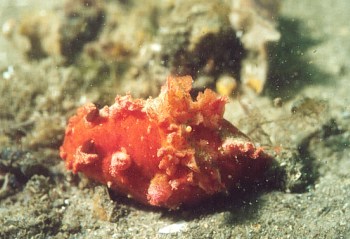

Hi,
We found this nudibranch at Clifton Gardens Wharf in Sydney harbour on 13 May 2000 [New South Wales, Australia]. We thought it might be Plocamopherus imperialis? We saw it during the day scrunched up -- when we came back at night it had starting moving about. It had a slimy trail stretching out behind it -- the water movement washed it about but it stayed 'stuck' to the silt. It was about 10cm long.
Cheers
Paula Zylstra
Harry Rothenfluh
hsrpz@netspeed.com.au
Zylstra,P. & Rothenfluh,P., 2000 (Jun 23) Plocamopherus imperialis? in Sydney. [Message in] Sea Slug Forum. Australian Museum, Sydney. Available from http://www.seaslugforum.net/find/2586Dear Paula & Harry,
Yes your animal is Plocamopherus imperialis, and at 10cm is about as big as it gets. The slimy trail you mention is often quite noticeable when nudibranchs crawl over fine muddy sediments. I'm not sure whether this is beacuse it is easier to see on mud or whether they have to produce more mucous secretions to deal with crawling over mud.
I have pointed an arrow at one of the large posterior 'knobs' that Plocamopherus has on each side of its mantle. If you have a look at the top of this page you will see that these organs produce light when they are disturbed, a bit like a firefly or glow-worm. If you come across one again on a night dive, a bit of vigorous (but gentle) prodding may produce a fascinating display for you.
In your lower photo the dorsal keel behind the gills is well displayed. This is used as a paddle to help the animal swim when it is disturbed.
Best wishes,
Bill Rudman.
Plocamopherus imperialis from New Zealand
December 21, 1998
From: Ross Armstrong
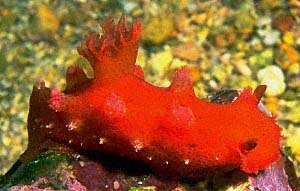
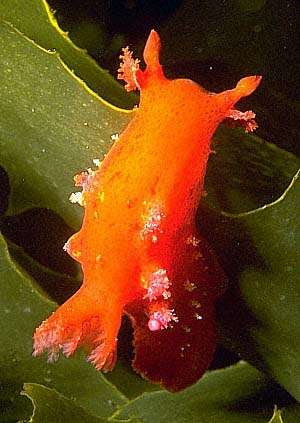
Hi Bill
Here are two photos of an animal I have seen only once. I have identified it as Plocamopherus imperialis. We found it on a night dive at the Poor Knights Island, northeastern New Zealand. Both photos are mine. A friend of mine claims to have seen one in Whangarei Harbour on a night dive.
cheers
Ross
Ross@northpower.co.nz
Armstrong, R., 1998 (Dec 21) Plocamopherus imperialis from New Zealand. [Message in] Sea Slug Forum. Australian Museum, Sydney. Available from http://www.seaslugforum.net/find/413Thanks Ross,
They are certainly more brightly coloured than southeastern Australian animals but the traces of small brown spotting in your photos and the large bulbous papillae, confirm they are Plocamopherus imperialis. They are apparently a rare visitor to New Zealand.
Cheers,
Bill Rudman.
